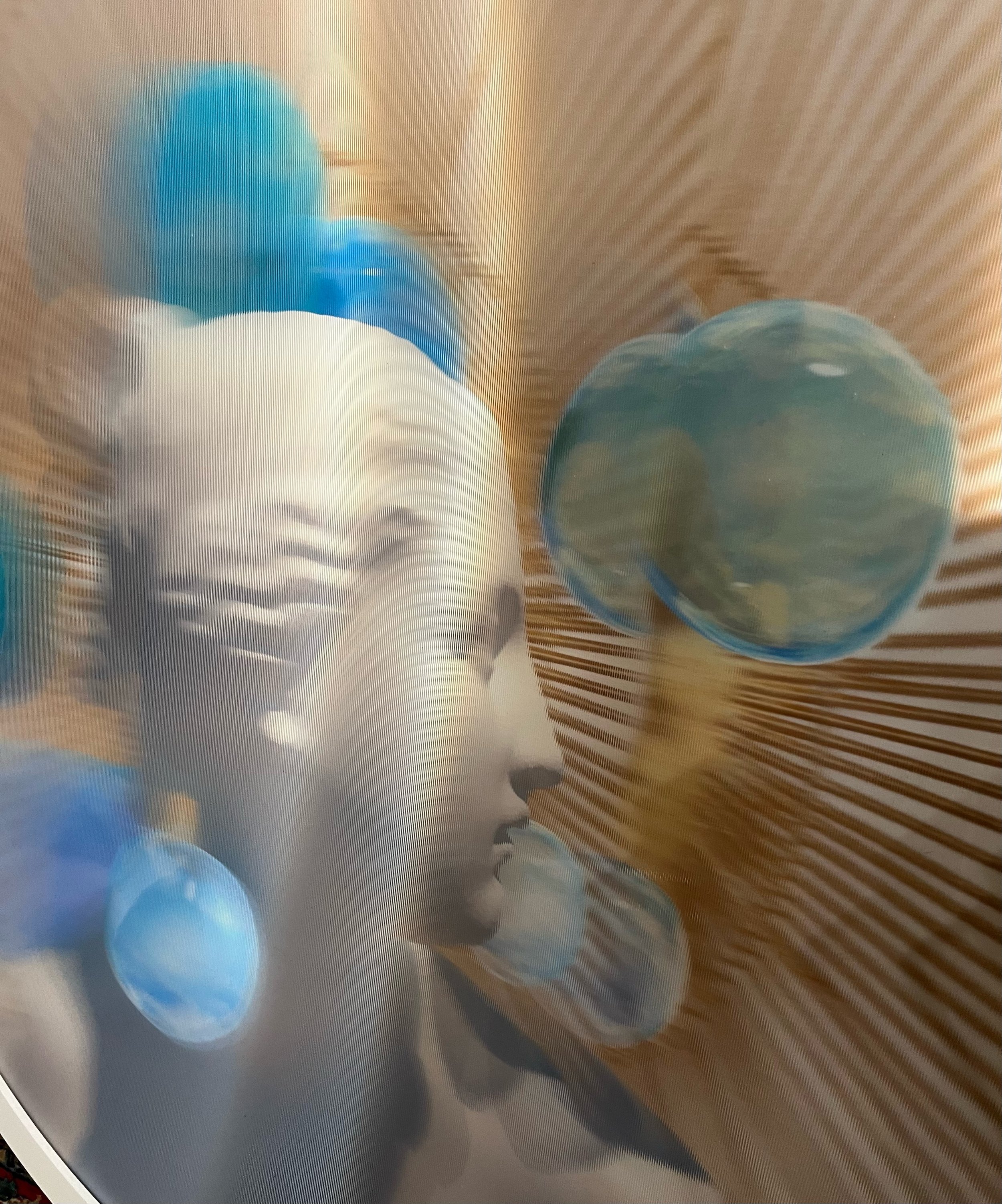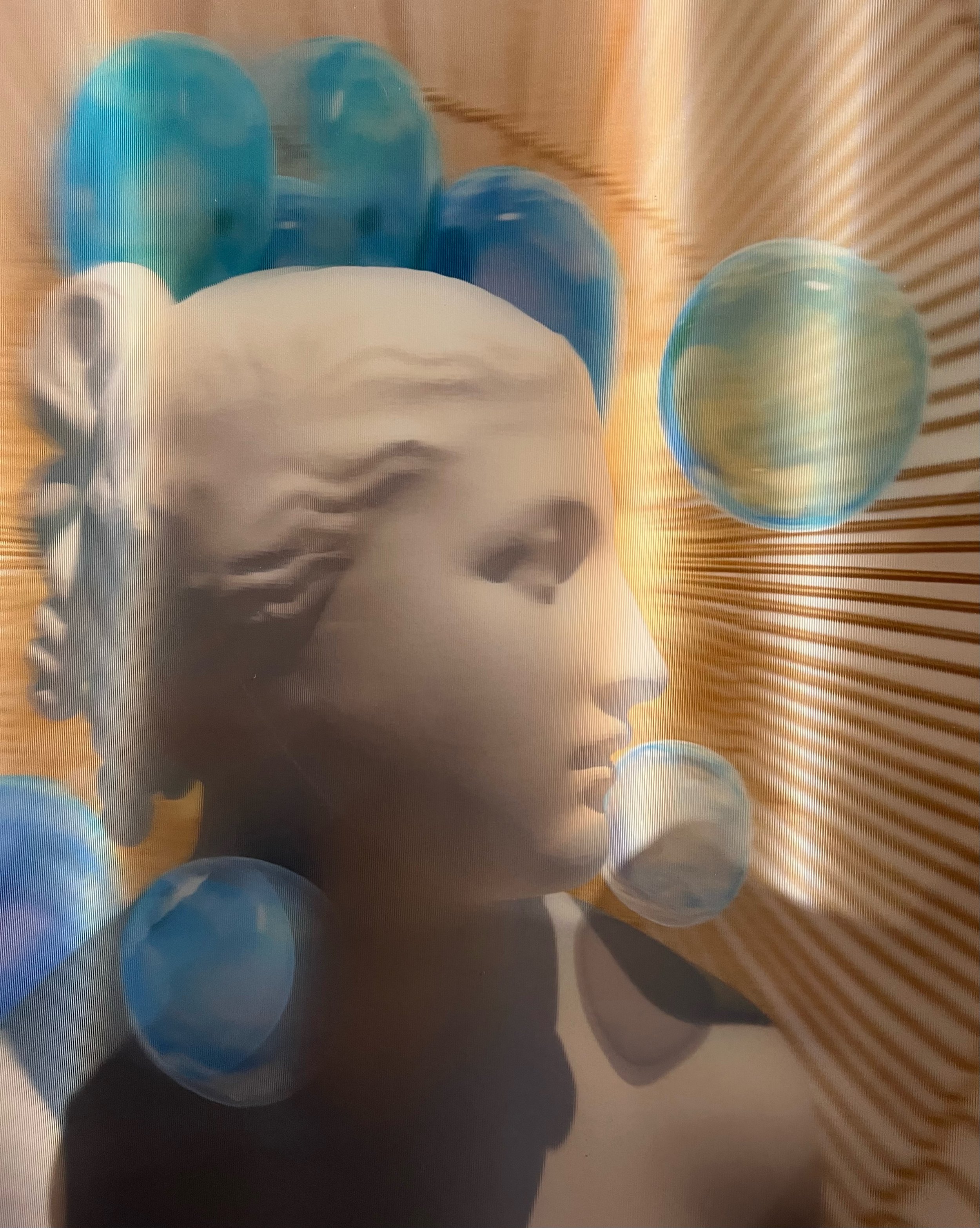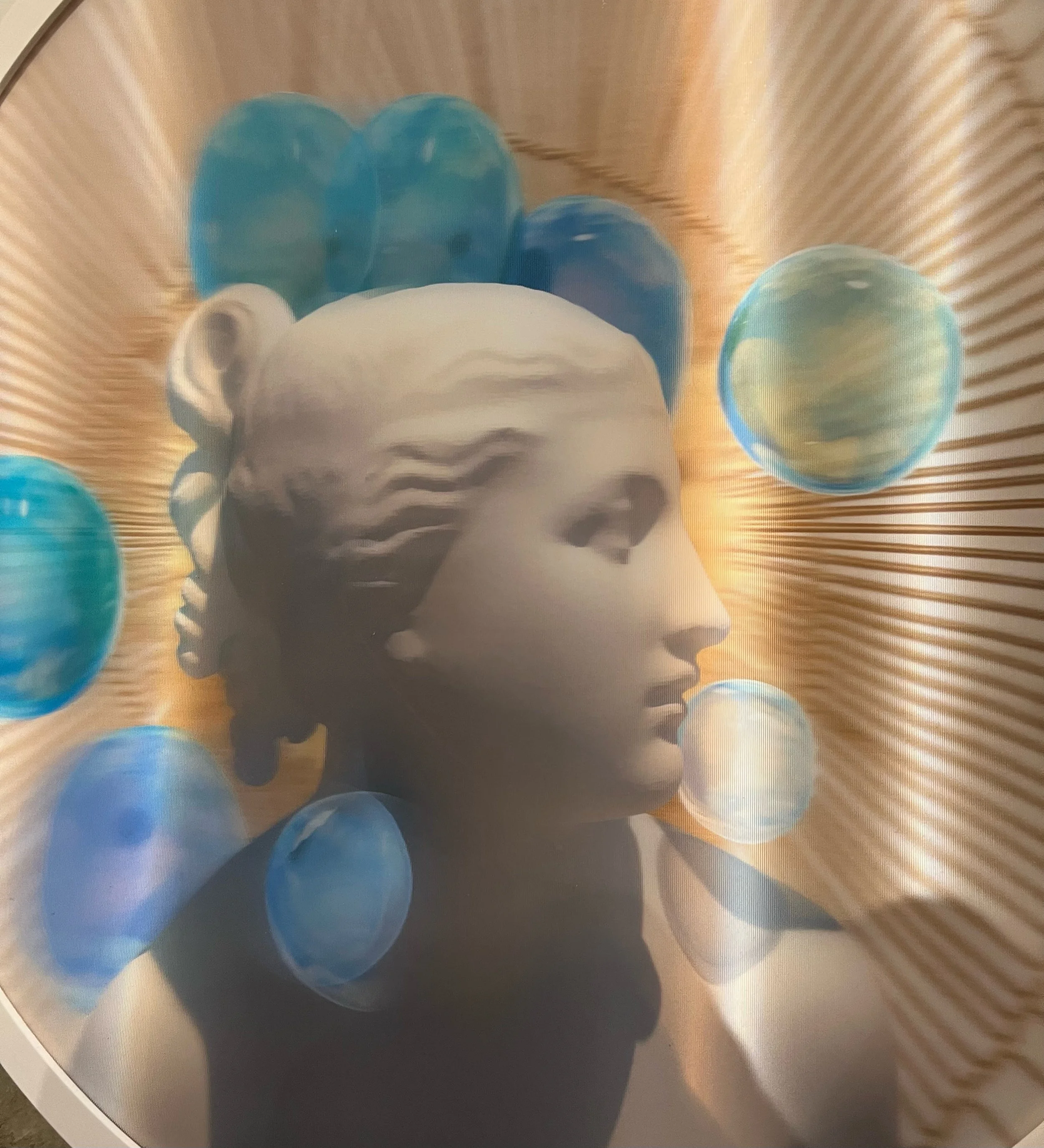Interview with Olga Tobreluts by Isabella Chalfant
Olga was born in 1970 in Murino, Leningrad Oblast, Russia. She has worked in multiple art mediums, but is best known for her digital work, pioneering a whole new art movement. The experimentation of her early works give way to some of her latest pieces called lenticulars. The images she creates are printed in a specific way so that they either follow the viewer or morph from one object to another as the viewer moves around the piece. Her story as an artist embodies a passion to create art so strong that no form of struggle could stop Tobreluts from achieving her artistic vision. The following interview delves into her life as an artist from when she started to making art to elaborating on her artist’s vision.
Question: What made you want to start creating digital art? Did you work in other primary mediums before starting digital work?
Olga: When I was 18, I realized that I wanted to paint large pictures on canvas but I had no place to live and work. Young people used to squat in deserted apartments. I found an empty apartment, 400 square meters, broke in, and began to live there. I slept on a sheet under a flannelette blanket on a parquet floor. I had a canvas 2x3 m. I painted an abstract painting, nitro enamel on canvas. It’s now in a museum collection. There were nails in the wall. I used them to hang my long dresses from second-hand stores. I had an obsession to create a masterpiece, so I slept on the floor, painting abstractions with nitro enamel that I picked at construction sites. Sometimes my artist friends would give me tubes of oil paints, which was the best present I could get. I had new ideas and visual possibilities. I realized that everything in the world – objects, plants, acts of nature – had already been given a name; we can’t dispose of that information and perceive those things in their original condition as an abstraction, an absolute.
In 1989, I wanted to make a film, in which a man dissolves in the world around him, transforming into a sign, and is then reborn. I also wanted to show that the environment stops being familiar and can still merge with man into a single matrix. Note that the very term “matrix” was not widely used at the time. There were no computers available either. I decided to experiment with 16 mm film. I painted huge backdrops, 4 by 6 meters, made of Soviet maps. We must have used hundreds of those maps. They were fantastically cheap: you could buy five maps for a kopeck. The Soviet Union was disintegrating, the borders were changing, and no one wanted those maps. It was just kilometers of wasted paper. I bought those maps, glued them together, and drew ornamental patterns on the backside. The characters were supposed to dissolve in them. It was very symbolical: on one side, there was the Soviet Union that had turned into a myth; on the other side, a yet unnamed ornamental space, in which characters – also covered with ornaments – lived and dissolved. I didn’t fully imagine the final result, but I wanted to convey the effect of dissolving and reappearing. Of course, 16 mm Kodak film was not enough for that experiment, and it looked more like a “parallel cinema.” When I first watched it after it was developed, I wanted to cry because I failed. Then I found out about the Offener Kanal in Berlin. Itwas a studio that any artist could use to make a film – however dumb – on condition that it would be shown on their TV channel. I sent them my script, and they indeed gave me everything I needed to film in Super VHS. My idea was to build an ornamented labyrinth and film a character inside. For the ornaments, I needed a photocopying machine. But color photocopies were expensive. I came to the owner of a photocopying shop, wearing a blue wig, matching his company’s color. I said to him: “You have a big shop window. I can make a free promo action for you: I’ll be standing in the window and keep photocopying page after page.” He agreed and allowed me to take all the sheets I’d have photocopied. That’s how I was able to make that magic ornament and make the film Experimental Laboratory No. 7. But after I watched the film, I realized that I hadn’t created the effect of an ideal collage I was looking for. At the time, collage was based on splicing. It helped the viewer identify it as a collage. With computer technologies, collage had turned into a sophisticated virtual reality. It was a very important change in the art of collage. I didn’t realize it then, but I was moving toward it instinctively. All those steps were a search for an “ideal collage.” Everyone seemed to be doing collages at the time, but they did it the old way. No one knew a thing about the computer, and they couldn’t have a perfect picture.
I found out that Babelsberg, a studio outside Berlin, had state-of-the-art computers. There was new equipment, the French were planning to make space travel films there; so I thought I’d succeed there. I came to the Babelsberg studio and met its directors. They looked at my project, watched the materials I’d filmed, and said that they’d let me use the studio and give more film, but they wouldn’t pay for actors. One of them was professor Ulrich Weinberg. He said to me: “I’m director of ArtCom institute and I can tell you for sure: you won’t be able to do that without a computer. What you want is called fractals. You can construct fractal geometry using a computer. You should come to us and learn what computers can do.” I came there and for the first time in my life I saw a virtual reality headset, the Photoshop software, and I was hysterical. It was 1991. I found out that everything I wanted had already been invented and my searches were in vain. Fractal geometry and self-generating fractals were the first to be visualized. I couldn’t speak for a month, I was deeply depressed.
A month later, I had a new idea: study the impact of media on human visual perception and whether that perception can be changed. I studied the computer and watched the man, recording the results with the media I had. I created the images of virtual time travels, and the photos from these travels acted as the proof that they were real. I studied new possibilities of perception and created new series. For example, Vermeer of Delft had a friend who was an optician. He explained to Vermeer that it’s not the eye that sees, but the brain. Vermeer became the greatest artist of the world. The secret of his art is simple though: he painted iridescent dots around highlights that are not visible to the eye but are clear to the brain. The brain thinks that these iridescent dots are a result of a bright light and increases the brightness. If you rub these iridescent dots off Vermeer’s paintings, they will fade.
Question: What is your vision as an artist?
Olga Tobreluts
Nimfa (Details)
2018
Master Edition 1/3
Stereo-Vario
40 Inch Diameter AVAILABLE AT THE MATNEY GALLERY
Olga: I’m a pioneer of media art. I’ve been experimenting with collage (virtual visual semantic windows) for 33 years. Every series of mine registered a change in the perception of the modern mind. However, with the advent of new computer technologies such as 3D modeling, collage has turned into an illusion of reality. It was now possible to dive into a virtual fantasy space, a real-life image without seams and stitches. This artificial space was visually more real than the real world. The modern mind had already begun to become fragmented when the new digital reality appeared and changed the properties of its visual apparatus. I register the changes in the visual perception of the modern mind caused by the influence of the information flow and social networks. The structural changes that music, architecture, theater, literature, language platforms, poetry, and data storage systems underwent in the 20th century are signs of change in perception in general and the formation of synthetic perception and a new visual code.
Olga Tobreluts
Dollar
2018
Lenticular Panel
39 x 39 Inches AVAILABLE AT MATNEY GALLERY
Question: How did you progress from your early work to the lenticulars? What inspired you to start creating the lenticulars and what about the imagery you chose spoke to you as an artist?
Olga: Lenticulars is a recent passion of mine. I have been making them in collaboration with programmer Yegor Korotkov since 2014. He developed an app that transforms a 3D object into 180 layers with varying perspectives. These layers are then printed on a lens, which creates a 3D image that looks as if it moves. We are the best in this because we combine technologies, art, and programming. We took part in the only professional lenticular competition, the DUPLA exhibition in Frankfurt, and received the highest award.
Every lenticular is a small story that can be conceptual and convey several ideas at once or it can just be a record of the artist’s current vision. I often try to reconstruct the emotion I feel, convey it to the viewer, and feel the feedback. Lenticulars not only convey an image, they can also grasp a momentary emotion of the artist and let the viewer feel it. For example, the fountain: I was in Rome that day, and it was so hot there that it felt like the city was melting. I saw a fountain and came up to it. I saw the splashes and droplets glistening in the sunlight. I’ll never forget what I felt at that moment, and I’m trying to convey it with a lenticular. I’ve been recently making quite simple figurative lenticulars that use volume, light, and color to convey an emotion. When I fully master that, I’ll move to abstract forms and will keep experimenting.
Question: What message do you hope to convey through your work? What do you want the viewer to take away from your art? What is your ultimate intention in creating art pieces?
Olga: I made an experimental painting. First, I made a 3D abstract image in Maya. Then I transferred it on canvas using classical painting technique stage by stage: drawing, underpainting, and the final paint layer. However, the human viewer could still unconsciously perceive the original digital image. Even when analogously reproduced by artists using classical painting techniques, this digital code was part of the real painting. Any digital device, be it a camera or a smartphone, can read that code and see the additional dimension: it detects the 3D object made by the computer and can change its volume in the augmented reality. However, any person standing in front of this painting will be seen as a 2D image. It’s an interesting method, and I keep studying it for use in practical experiments.





